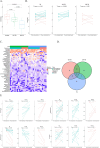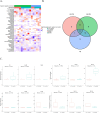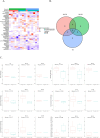Dynamic changes of respiratory microbiota associated with treatment outcome in drug-sensitive and drug-resistant pulmonary tuberculosis
- PMID: 39252020
- PMCID: PMC11385506
- DOI: 10.1186/s12941-024-00742-y
Dynamic changes of respiratory microbiota associated with treatment outcome in drug-sensitive and drug-resistant pulmonary tuberculosis
Abstract
Background: Respiratory microbiota is closely related to tuberculosis (TB) initiation and progression. However, the dynamic changes of respiratory microbiota during treatment and its association with TB progression remains unclear.
Methods: A total of 16 healthy individuals and 16 TB patients (10 drug-sensitive TB (DS-TB) and 6 drug-resistant TB (DR-TB)) were recruited. Sputum samples were collected at baseline for all anticipants and after anti-TB treatment at Month-6 for TB patients. High throughput 16 S RNA sequencing was used to characterize the respiratory microbiota composition.
Results: Compared to the healthy individuals, TB patients exhibited lower respiratory microbiota diversity (p < 0.05). This disruption was alleviated after anti-TB treatment, especially for DS-TB patients. Parvimonas spp. numbers significantly increased after six months of anti-TB treatment in both DS-TB and DR-TB patients (p < 0.05). Rothia spp. increase during treatment was associated with longer sputum-culture conversion time and worse pulmonary lesion absorption (p < 0.05). Besides, Moraxella spp. prevalence was associated with longer sputum-culture conversion time, while Gemella spp. increase was associated with worsening resolving of pulmonary lesions (p < 0.05).
Conclusion: Dynamic changes of respiratory microbiota during anti-TB treatment is closely related to TB progression. The involvement of critical microorganisms, such as Parvimonas spp., Rothia spp., Moraxella, and Gemella spp., appears to be associated with pulmonary inflammatory conditions, particularly among DR-TB. These microorganisms could potentially serve as biomarkers or even as targets for therapeutic intervention to enhance the prognosis of tuberculosis patients.
Keywords: Respiratory microbiota; Treatment outcome; Tuberculosis.
© 2024. The Author(s).
Conflict of interest statement
The authors declare no competing interests.
Figures



Similar articles
-
Time to sputum culture conversion in multidrug-resistant tuberculosis: predictors and relationship to treatment outcome.Ann Intern Med. 2006 May 2;144(9):650-9. doi: 10.7326/0003-4819-144-9-200605020-00008. Ann Intern Med. 2006. PMID: 16670134
-
Sputum microbiota as a potential diagnostic marker for multidrug-resistant tuberculosis.Int J Med Sci. 2021 Mar 3;18(9):1935-1945. doi: 10.7150/ijms.53492. eCollection 2021. Int J Med Sci. 2021. PMID: 33850462 Free PMC article.
-
The impact of anti-tuberculosis treatment on respiratory tract microbiome in pulmonary tuberculosis.Microbes Infect. 2025 Mar-Apr;27(3):105432. doi: 10.1016/j.micinf.2024.105432. Epub 2024 Oct 19. Microbes Infect. 2025. PMID: 39428055
-
Delamanid: From discovery to its use for pulmonary multidrug-resistant tuberculosis (MDR-TB).Tuberculosis (Edinb). 2018 Jul;111:20-30. doi: 10.1016/j.tube.2018.04.008. Epub 2018 May 3. Tuberculosis (Edinb). 2018. PMID: 30029909 Review.
-
Time to sputum culture conversion and its associated factors among multidrug-resistant tuberculosis patients in Eastern Africa: A systematic review and meta-analysis.Int J Infect Dis. 2020 Sep;98:230-236. doi: 10.1016/j.ijid.2020.06.029. Epub 2020 Jun 12. Int J Infect Dis. 2020. PMID: 32535296
References
-
- Bagcchi S, WHO’s global tuberculosis report. 2022. The Lancet Microbe. 2023;4(1):e20. - PubMed
-
- World Health Organization. Global tuberculosis report 2023. Geneva:World Health Qrganization; 2023.
MeSH terms
Substances
Grants and funding
- 2024A03J0585/Guangzhou Science and Technology Bureau Municipal-University(Institute) Joint Funding Project
- 2024A03J0585/Guangzhou Science and Technology Bureau Municipal-University(Institute) Joint Funding Project
- A2019342/Guangdong Provincial Health Commission Funding
- A2019342/Guangdong Provincial Health Commission Funding
LinkOut - more resources
Full Text Sources
Miscellaneous

